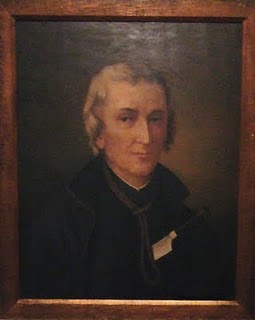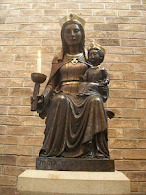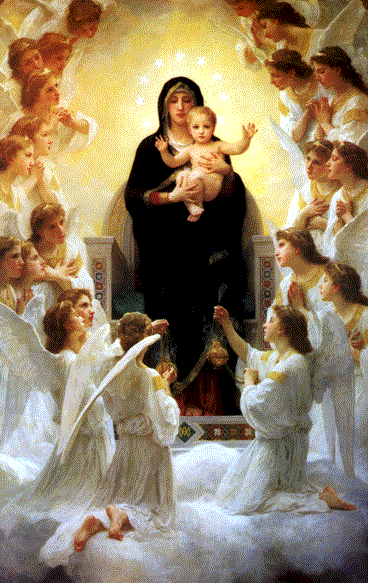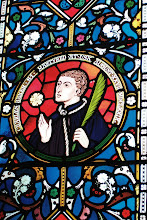Today, 12th July, we celebrate the Memorial of a Welsh Franciscan, St John Jones.
 |
| ST JOHN JONES O F M |
John Jones was born to recusant Catholic parents at Clynnog Fawr near Caernarvon, Wales. The date of his birth is uncertain but it was possibly around 1530. He entered the Observant Franciscan Convent at Greenwich, taking the name of Godfrey Maurice. At its dissolution in 1559 he and his fellow friars fled to the Continent and John was professed at Pontoise, France.
After many years John travelled to Rome where he stayed at the Ara Coeli Franciscan Observant House. Then, in 1591, he joined the Roman Province of the reformed Franciscan Order of Strict Observance. (This was one of the strictest orders and the first to be suppressed by King Henry VIII.)
Despite being aware that a priest going on the English Mission often ended his days being hanged, drawn and quartered, John Jones begged his superiors to send him. They acquiesced and he was granted an audience with Pope Clement VII from whom he received a special blessing. Pope Clement told him “Go, for I believe that you are a true religious of St Francis. Pray to God for me and for His Holy Church.”
The Franciscan Friar arrived in London in late 1592. At first he worked in the London area, finding shelter in the London house of St Anne Line. Eventually he extended his work to different parts of the country. At that time it was necessary for Catholic priests working clandestinely in the country to use one or more aliases. John Jones had several. He was also known as John Buckley, John Griffith and Godfrey Maurice. He was held in high esteem by his fellow Franciscans and they elected him as their Provincial.
 |
| SITE OF INFAMOUS CLINK PRISON |
In 1596 Fr Jones was captured by the ruthless Richard Topcliffe and sent to the infamous Clink prison. Topcliffe held a deep hatred of Catholics and would stop at nothing to eradicate the Faith in England. John was mercilessly tortured and even scourged. The priest was then taken to Topcliffe’s house where the torture continued. Astonishingly, the Queen allowed Topcliffe to maintain a private torture chamber in his house for the interrogation of the Catholic priests he apprehended.
On 3rd July 1598 Fr John Jones was brought to trial for having exercised his ministry as a Catholic priest in England. He was tried alongside Jane Wiseman and Robert Barnes. The charges against Wiseman and Barnes were that they had feloniously received and comforted a priest. Fr Jones said he had never been guilty of any treason against his Queen or country and that he wished his case to be referred to the conscience of the judge rather than to an ignorant jury. Judge Clinch informed him that they were aware he was no plotter but he was a Romish priest who had returned to this country contrary to the statute of 1585 and this was deemed to be High Treason. (Statute 27 Elizabeth)
At the trial, Robert Barnes was permitted to make a long defence by which he disproved the evidence against them and exposed the underhand and brutal methods used by Topcliffe to obtain evidence against Catholics. As a result of this trial, Topcliffe was discredited and shortly after he retired to the country. Nevertheless, Barnes and Wiseman were condemned to death but they were later reprieved.
Fr Jones was found guilty of High Treason and sentenced to be hanged, drawn and quartered. Early on the morning of 12th July 1598, he was taken to St Thomas Waterings, Southwark, where Albany Road meets the Old Kent Road. Here he had to stand and wait for an hour because, amazingly, the hangman had forgotten to bring the rope! John used the hour well, saying his prayers and preaching to the crowd who had come to witness the martyrdom of this well loved priest.
When the rope was finally brought, John Jones was hanged until dead. His body was then cut down, disembowelled and quartered. His quarters were fixed atop poles on roads to Newington and Lambeth and his head displayed in Southwark. Some brave Catholics later recovered his body parts. This was a dangerous thing to do and at least one of the Catholics was caught and imprisoned for this act.
In 1929 John Jones O F M was beatified by Pope Pius XI. On 25th October 1970, Pope Paul VI canonised two Franciscans, Fr John Jones and Fr John Wall, and thirty-eight others as the Forty Martyrs of England and Wales.








.JPG)

.JPG)






Thanks for this post Breadgirl, truly excellent.
ReplyDeleteYou really are amazing with your well researched historical stories of the Saints and Welsh heritage. What a wonderful dedication.
ReplyDeleteGod bless you and yours.
Richard & Victor
ReplyDeleteThank you both for your kind remarks. Thanks too for taking the time to leave a comment.
God bless you both.